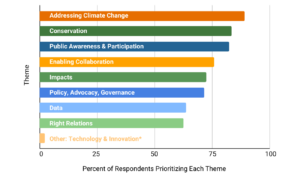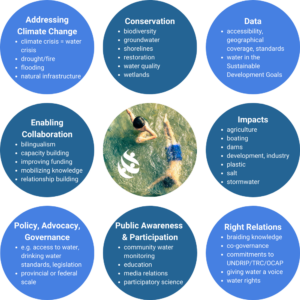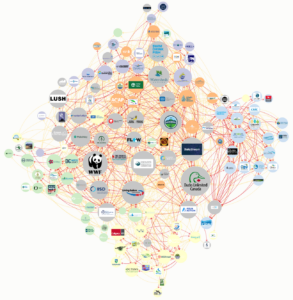“Mapping and conversations are always two sides of the same coin. A map without conversations is nothing and conversations without some form of mapping [are] much more fragmented.” ~from Greater than the Sum’s interview series with Aldo de Moor, part 6
OLW’s annual survey has evolved since it began, from a focus on impact measures in the Shared Measurement System (examples 1, 2, 3), to more recent evaluations of the Network’s services and connectivity (examples 1, 2). This year, we leveraged the survey to create a prototype map that reflects Network organizations’ relationships and explores collaborative opportunities, successes and gaps. The map even incorporates OLW Network priorities into one layer so that we can all see who is working on what and with whom.
The chart below shows the broad themes we added to the prototype map, ranked in descending order of priority by member organizations in the 2023-2024 annual survey:

Refer to the following image for examples of each broad theme. *Note that Technology & Innovation was the only theme in ‘Other’ added by survey respondents.

Why Undertake Network Mapping?
For a deep dive into why network mapping matters, read Greater than the Sum’s interview series with Aldo de Moor, parts 1, 2, 3, 4, 5, 6. |
According to Aldo de Moor, founder of CommunitySense, two big reasons network mapping is important include sensemaking and overcoming fragmentation.
Sensemaking: This is really “the process by which people give meaning to their collective experiences” (Organization Science: Organizing and the Process of Sensemaking). When we are working on a complex problem like ‘all waters in Canada in good health by 2030’, most of us focus on the day-to-day in relation to one place or one aspect of this ambitious goal, narrowing our point of view and reducing our potential impact. It’s actually really hard to see the whole picture, and mapping can help us do this.
Overcoming fragmentation: As a result of working in geographic, thematic or jurisdictional silos, we may reinvent the wheel or never benefit from others’ knowledge and experience. Maps can help us design collaboration intentionally so we avoid these pitfalls and solve difficult problems by harnessing energy, resources, power and influence.
Ensuring Network Mapping is Useful
“If I’m hiking through unknown rugged territory, having a good map in my pack makes it possible for me to find my destination. But if I never learn to read that map – the map is useless. The map makes not getting lost possible, but it only works if I engage with it intelligently.” ~from Greater than the Sum’s interview series with Aldo de Moor, part 2, quote edited for brevity
For a mapping process to be successful, stakeholders need to take part in an iterative feedback loop of mapping, sensemaking, community building, and evaluation. Essentially, the map has to be used over time by incorporating it into Network operations.
In OLW’s process, we’re still in the mapping phase. We collected data through the annual survey for our prototype map, then gathered initial feedback from Network members at an OLW June Meetup, and will continue to do so over the coming months. Over time, conversations centered on the map’s framework can help inform our common agenda and make our Network stronger. New map iterations can track that change through time, like in this case study. We’ll work towards making sure the map is inclusive, giving voice to all stakeholders who want to participate and incorporating language that is meaningful to water leaders.
June 2024 view of the OLW prototype Network map. To explore the many ways mapping is used for collective action, check out Kumu’s project gallery. |
Stay tuned for more opportunities to participate in our Network mapping process and give feedback. For more information or to explore the current map, reach out to info@ourlivingwaters.ca.
